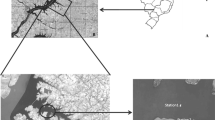Abstract
Enumeration of nitrogen fixing bacterial population in water and sediment samples of six fish farming ponds (polyculture, monoculture and traditional systems) over a period of two and a half years revealed significant differences between the culture systems with maximal and lowest counts in the monoculture and traditional systems, respectively. Polynomial equations of the 2nd to 4th degree were used to represent the observed seasonal data in these ponds. The bacterial populations peaked in summer, while the lowest count was observed in winter. The environmental factors such as pH, different species of nitrogen, dissolved organic carbon were responsible for the seasonal changes in nitrogen fixing bacteria.
Similar content being viewed by others
References
Alexander, M., 1978. Introduction to soil microbiology. 2nd Edn. Wiley Eastern Limited, New Delhi, 467 pp.
Allen, D. A., B. Austin & R. R. Colwell, 1983. Numerical taxonomy of bacterial isolates associated with a freshwater fishery. J. gen. Microbiol. 129: 2043–2062.
American Public Health Association, 1976. Standard methods for the examination of water and wastewater. 14th Edn. A.P.H.A., Wash. D.C., 874 pp.
Anderson, G. R., 1955. Nitrogen fixing by Pseudomonas like soil bacteria, J. Bact. 70: 129–133.
Antipchuk, A. F., 1979. Microbiological control in the fish farming ponds. Pishch. Prom., 145 pp. (in Russian).
Brezonik, P. L., 1972. Nitrogen: Sources and transformation in natural waters. In H. E. Allen & J. R. Kramer (eds), Nutrients in natural waters. Wiley Interscience Publications, N.Y.: 1–50.
Brouzes, R., J. Lasik & R. Knowles, 1969. Effect of organic amendments, water content and oxygen on the incorporation of 5N2 by some agricultural and forest soils. Can. J. Microbiol. 15: 899–905.
Deufel, J., 1965. Plotzliche Zunahme von Azotobacter im Bodensee. Naturwissench. 52: 192–193.
Dierberg, E. E. & P. L. Brezonik, 1981. Nitrogen fixation (acetylene reduction) associated with decaying leaves of pond cypress (Taxodium distichum var. natans) in a nature and sewage enriched cypress dome. Appl. envir. Microbiol. 41: 1413–1418.
El-Samra, M. I. & J. Olah, 1980. Magnitude and pattern of nitrogen fixation in fish ponds. Aquacult. Hungar. (Szarvas) 2: 94–104.
Herbert, R. A., C. M. Brown & S. C. Stanley, 1977. Nitrogen assimilation in marine environments. In F. A. Skinner & J. M. Shewan, Aquatic microbiology. Academic Press, Lond.: 161–177.
Jana, B. B. & S. K. Roy, 1983. Estimates of microbial populations involved in nitrogen cycle and their activity in water and sediments of fish ponds under mono and polyculture systems in India. Int. Revue ges. Hydrobiol. 68: 581–590.
Jana, B. B. & G. N. Patel, 984. Spatial and seasonal variations of phosphate solubilizing bacteria in fish ponds of varying fish farming managements. Arch. Hydrobiol. 101: 555–568.
Jana, B. B. & G. N. Patel, 1985. Distribution pattern of sulphate reducing and thiosulphate oxidising bacterial populations in fish ponds of differing farming managements. Hydrobiologia 127: 171–186.
Jana, B. B. & S. K. Roy, 1985a. Distribution patterns of protein mineralizing and ammonifying bacterial populations in fish farming ponds under different management systems. Aquaculture 44: 57–65.
Jana, B. B. & S. K. Roy, 1985b. Spatial and temporal changes of nitrifying bacterial populations in fish ponds of differing management. J. appl. Bact. 59: 486–495.
Jones, J. G., B. M. Simon & R. W. Horsley, 1982. Microbiological sources of ammonia in freshwater lake sediments. J. gen, Microbiol. 128: 2823–2831.
Jones, K., 1982. Nitrogen fixation in the temperate estuarine intertidal sediments of the river Lune. Limnol. Oceanogr. 27: 455–460.
Jones, J. G. & B. M. Simon, 1981. Differences in microbial decomposition processes in profundal and littoral lake sediments, with particular reference to the nitrogen cycle. J. gen. Microbiol. 123: 297–312.
Keeney, D. R., 1973. The nitrogen cycle in sediment water systems. J. envir. Qual. 2: 15–29.
Keeney, D. R., 1976. The fate of nitrogen in aquatic ecosystems. Lit. Rev. 3. Wat. Resour. Cent., Univ. Wisconsin, 59 pp.
Kuznetsov, S. I., 1970. Microflora of lakes and their geochemical activities. Lenningrad, Izdstelt Istro Nauka, 440 pp. (in Russian).
Lundgren, A., 1978. Nitrogen fixation iduced by phosphorus fertilization of a surbarctic lake. Ecol. Bull. (Stockholm) 26: 52–59.
Mulder, E. G., 1975. Physiology and ecology of free living, nitrogen fixing bacteria. In, W. D. P. Stewart (ed.), Nitrogen fixation by free-living microorganisms. Cambridge University Press, Lond.: 3–28.
Niewolak, S., 1972. Fixation of atmospheric nitrogen by Azotobacter sp. and other heterotrophic oligonitrophilous bacteria in Ilawa lakes. Acta Hydrobiol. 14: 287–305.
Rheinheimer, G., 1980. Aquatic microbiology, 2nd Edn. John Wiley & Sons, N.Y., 235 pp.
Roy, S. K., 1984. Spatial and seasonal distributions of microbial populations involved in nitrogen cycle and their activity in fish farming ponds under traditional, monoculture and polyculture systems. Ph.D. Thesis, Univ. Kalyani, West Bengal, India, 294 pp.
Sprent, J. I., 1979. The Biology of Nitrogen fixing organisms. McGraw Hill, Lond.
Stewart, W. D. P., 1975. Nitrogen fixation by free living microorganisms. Cambridge University Press, Lond., 471 pp.
Stewart, W. D. P., F. Sinada, N. Christofi & M. J. Daft, 1977. Primary production and microbial activity in Scottish freshwater habitats. In R. A. Skinner & J. M. Shewan (ed.), Aquatic microbiology. Academic Press, Lond.: 31–54.
Stewart, W. D. P., T. Preston, H. G. Peterson & N. Christofi, 1982. Nitrogen cycling in eutrophic freshwaters. Phil. Trans. r. Soc. B 296: 491–509.
Waksman, S. A., 1952. Soil microbiology. John Wiley & Sons. N.Y., 356 pp.
Wetzel, R. G., 1983. Limnology. 2nd Edn. Saunders Co. Philad., 860 pp.
Zelitch, I., 1951. Simultaneous use of molecular nitrogen and ammonia by Clostridium pasteurianum. Proc. natn. Acad. Sci. 37: 559–565.
Author information
Authors and Affiliations
Rights and permissions
About this article
Cite this article
Jana, B.B., Roy, S.K. Seasonal and spatial distribution pattern of nitrogen fixing bacteria in fish ponds under different management systems. Hydrobiologia 137, 45–54 (1986). https://doi.org/10.1007/BF00004171
Received:
Accepted:
Issue Date:
DOI: https://doi.org/10.1007/BF00004171




